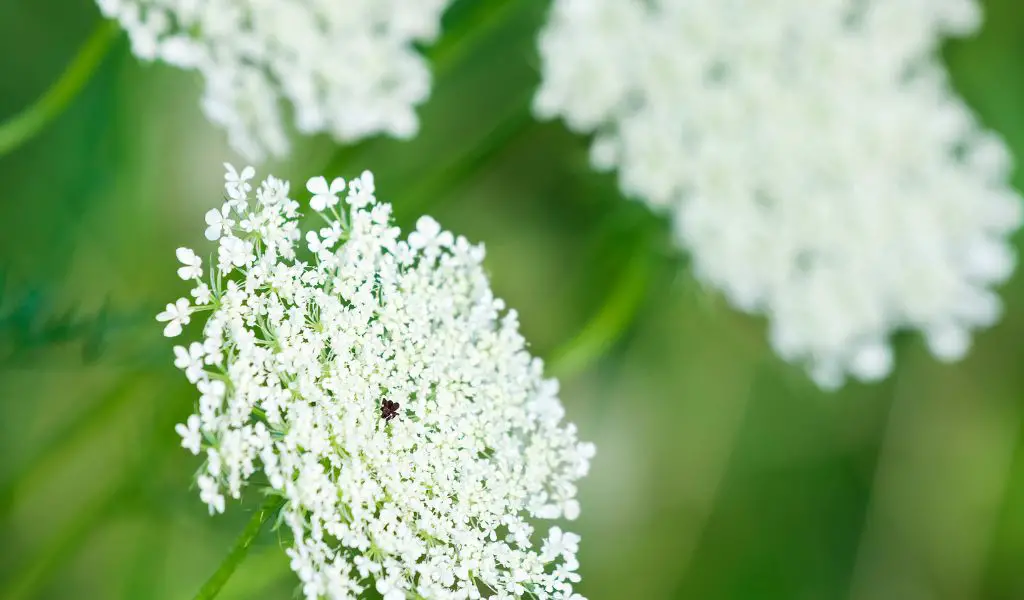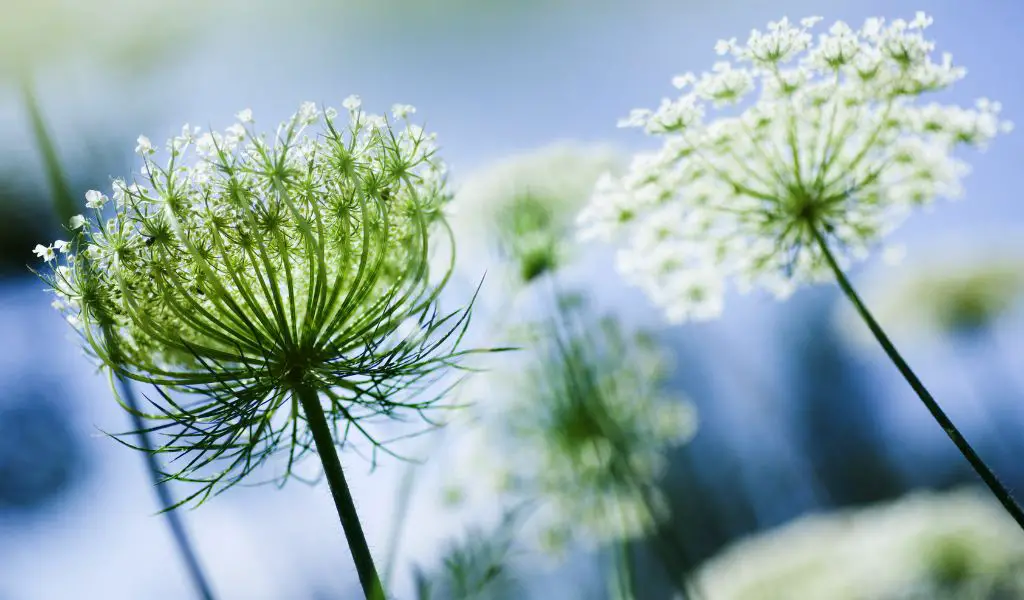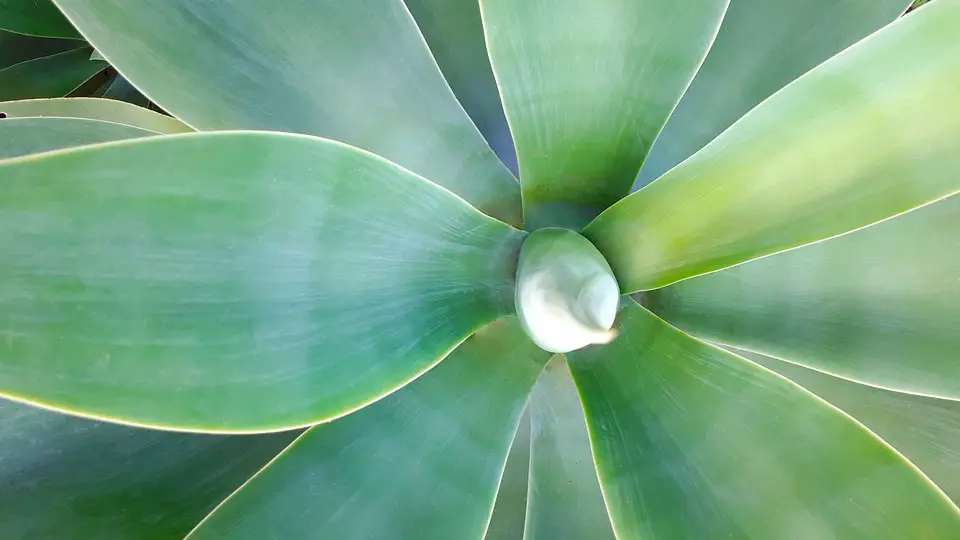The Beauty of Queen Anne’s Lace in a Container: An Introduction
Queen Anne’s Lace, also known as Wild Carrot, is a delicate and beautiful flowering plant that can add an elegant touch to any garden.
With its lacy white blossoms and fern-like foliage, this plant has become a favorite of many gardeners.
While it is commonly found growing wild in open fields and along roadsides, it can also be grown successfully in containers with the right care and attention.
As more people turn to urban living or have limited outdoor space, container gardening has become increasingly popular.
Growing plants in containers offer numerous benefits that make it an ideal option for those who love gardening but have limited space or access to ground soil.

For instance, container gardening allows you to grow plants on rooftops, balconies, porches or decks where there may not be enough soil for traditional planting methods.
Containers are also portable which makes it easier to move your plants around based on different weather conditions.
Growing Queen Anne’s Lace in a container can help capture the beauty of nature while providing flexibility for those with limited space.
It is vital to understand the advantages and disadvantages associated with growing this plant in a container before you proceed with it as your next project.
With proper care and attention, you will find that this flowering plant will provide years of enjoyment whether grown indoors or outdoors.
Advantages and Disadvantages of Growing Queen Anne’s Lace in a Container
Portability and Versatility
Growing Queen Anne’s Lace in a container offers the advantage of portability and versatility.
Containers can be placed anywhere that receives optimal sunlight, allowing gardeners to move their plants around as needed.
This is particularly useful for those who do not have large outdoor spaces or who live in areas with limited space.
Additionally, different types of containers can be used to create a unique look that complements the surrounding area.
Control over Soil Quality and Moisture Levels
Another advantage of growing Queen Anne’s Lace in a container is the amount of control gardeners have over soil quality and moisture levels.
In traditional gardening, it can be difficult to ensure that the soil has the right nutrients and pH balance needed for optimal growth.
With container gardening, however, gardeners can select specific types of soil mixes suited to their plant’s needs, ensuring better growth rates.
Additionally, containers make it easier to regulate watering schedules by preventing over or under-watering.
Protection from Pests and Diseases
Container gardening also provides protection from pests and diseases that commonly affect outdoor plants.
In-ground plants are more susceptible to insect infestations like aphids or spider mites as well as plant diseases caused by fungi or bacteria present in the soil. By growing Queen Anne’s Lace in a container, you can avoid these issues entirely.
Limited Space for Root Growth
Despite its advantages, growing Queen Anne’s Lace in a container does come with some disadvantages.
One major disadvantage is limited space for root growth which results from confining the plant within a smaller area than if it were planted directly into the ground where roots could spread freely.
This limits nutrient uptake which may result in stunted growth or reduced yield.
Regular Watering and Fertilization Required
Another disadvantage of container gardening is that it requires regular watering and fertilization to ensure the plant has all the nutrients it needs to grow properly.
This can be tedious for some gardeners who may not have time to water their plants on a daily basis.
Additionally, because containers tend to dry out faster than soil in the ground, gardeners need to be diligent in their watering schedules or risk killing the plant due to lack of moisture.
Choosing the Right Container for Queen Anne’s Lace
Growing Queen Anne’s lace in a container is not only an easy way to add beauty to your space but also allows you to have more control over the plant’s environment.
When choosing a container, you need to consider several factors. These include size, material, and drainage requirements.
Size Considerations
The size of the container will play a significant role in how well your Queen Anne’s lace will grow. The larger the container, the more room your plant will have to grow and develop healthy roots.
Generally speaking, containers that are 12-18 inches in diameter and 12-18 inches deep are ideal for growing Queen Anne’s lace. However, if you plan on growing multiple plants or want larger plants, you may need even bigger containers.
Material Options
There are many different materials from which containers can be made. Some of the most commonly used materials include plastic, terracotta or clay pots, metal tins or troughs and wooden boxes or barrels.
Each material has its unique advantages and disadvantages when it comes to growing queen anne’s lace. Plastic containers come in various sizes and shapes making them an excellent option if you want something lightweight that is easy to move around.
Terracotta pots provide good drainage but can dry out quickly due to their porous nature; they also tend to be fragile as they break easily if dropped accidentally.
Metal containers can get hot quickly under direct sunlight which might burn sensitive roots while wooden boxes require liner so that it does not rot and deteriorate over time.
Drainage Requirements
Queen anne’s lace prefers soil that is moist but not waterlogged; therefore good drainage is crucial when growing this plant in a container. Poorly drained soil can lead to root rot or fungal diseases which could harm your plant.
To ensure good drainage, you need to choose a container with drainage holes on the bottom or drill some holes if there are none. Additionally, adding pebbles or gravel at the bottom of the container can aid in draining excess water from the soil.
Preparing the soil mix for Queen Anne’s Lace in a container
Queen Anne’s Lace is a hardy plant that can grow in various soil types. However, it thrives best in well-draining soils that are rich in organic matter.
When preparing the soil mix for Queen Anne’s Lace, consider its unique requirements to ensure optimal growth and yield. The following are some factors to consider when preparing the soil mix.
Soil type preferences
Queen Anne’s Lace prefers loamy or sandy soils with a pH of 6.0 to 7.5. These soils provide good drainage and allow air circulation around the roots, which is essential for healthy plant growth.
Heavy clay-type soils should be amended with organic matter such as compost or peat moss to improve drainage and texture.
Soil amendments for optimal growth
Adding organic matter such as compost or aged manure to the soil mix provides essential nutrients required by Queen Anne’s Lace plants during their growing season.
Compost helps retain moisture and improve soil structure, thereby increasing nutrient availability to the plant roots.
Similarly, adding perlite or vermiculite improves drainage and prevents waterlogging of the roots. In addition to these amendments, adding slow-release fertilizers such as bone meal or fish emulsion provides nutrients throughout the growing season without overfeeding the plants and risking fertilizer burn.
It is important not to add too much fertilizer at once since overdosing can scorch delicate plants like this one.
By considering these factors when preparing the soil mix for Queen Anne’s Lace in a container, you will create an ideal environment that promotes plant growth and development while reducing stress on your plants due to imbalanced nutrition or water retention issues that could result from using unsuitable potting mixes.
Growing techniques for Queen Anne’s Lace in a container
Seed propagation technique
Growing Queen Anne’s Lace from seeds is an inexpensive and easy way to start your container garden.
Start by filling your container with a well-draining potting mix, which should be moistened prior to planting the seeds. Plant the seeds at a depth of 1/8 inch and cover them lightly with soil.
It is important to keep the soil consistently moist until the seedlings emerge, which can take up to 20 days.
After that, reduce watering frequency but ensure that the soil remains evenly moist as excessive dryness can cause damage to plant roots.
Once seedlings reach a height of about 2 inches, thin them out by spacing them 6-9 inches apart. This will ensure adequate space for root development and proper growth of individual plants.
Transplanting technique
Transplanting Queen Anne’s Lace from an outdoor garden into a container requires some preparation before digging out the plant. First, water the plant thoroughly a day or two before transplanting to make sure it has enough moisture in its system.
When it comes time to transplant, use a shovel or garden fork to dig around the root ball and lift it out carefully without damaging any roots. Select a spacious container that allows for room for growth as well as proper drainage holes at the bottom.
Fill your new container with potting mix, leaving space at the top of your new pot so you can plant your Queen Anne’s Lace at around its original level in soil line. Firmly tamp down on the soil around your newly transplanted plant so there are no air pockets left behind.
After transplanting, give your newly potted plants water immediately after planting. Make sure you continue watering regularly until they have established themselves thoroughly in their new environment.
Creative subtitle: Two different ways to grow, one shared goal: A thriving Queen Anne’s Lace container garden
Care and Maintenance of Queen Anne’s Lace in a Container
Once your Queen Anne’s Lace plant is growing in a container, there are several essential care and maintenance practices to ensure its health and vitality. These include watering requirements, fertilizer application, pruning techniques, and protecting it from pests and diseases.
Watering Requirements
Queen Anne’s Lace plants grown in containers require regular watering to maintain healthy growth. The frequency of watering depends on the size of the container, soil type and the surrounding climate. You should aim to keep the soil consistently moist but not waterlogged.
Overwatering can lead to root rot disease, while underwatering can cause stunted growth or plant deaths. The best way to check if your Queen Anne’s Lace needs watering is by sticking your finger into the soil; if it feels dry at a depth of about an inch below the surface, then you need to water.
Water thoroughly until water runs out of drainage holes at the bottom of the container; this ensures that all roots receive enough moisture. During hot summer months or heatwaves, you may need to increase watering frequency or provide shade during peak sunlight hours.
Fertilizer Application
Queen Anne’s Lace plants require regular feeding with balanced fertilizers for optimal growth and blooming. When growing in containers, nutrients can leach out quickly due to frequent watering and limited soil volume; hence they require more frequent feeding than those grown in gardens.
You should apply fertilizer at least once every two weeks during active growth periods (spring-summer) using half-strength liquid fertilizer mixed with water.
An alternative approach is using slow-release fertilizers that last up to six months before reapplication is necessary. Ensure not to over-fertilize as excessive nutrients can cause foliage burn or attract pests.
Pruning Techniques
Queen Anne’s Lace plants benefit from regular pruning to maintain healthy growth, shape and size. Pruning also encourages more blooming and delays seed formation, making the plant more attractive for longer.
You should remove dead or damaged stems, spent flowers and yellowing leaves regularly to prevent the spread of diseases. To promote bushier growth, you can pinch back stem tips by up to a third of their length.
This stimulates branching and lateral shoot growth. For a more formal appearance, you can trim back stems after flowering by up to half their length, taking care not to remove too much foliage as this can weaken the plant.
Harvesting and Using Queen Anne’s Lace Grown in a Container
Harvesting Techniques
Queen Anne’s Lace blooms from midsummer through fall, with the flowers peaking in late August and early September. When harvesting, look for flower heads that are almost fully open but not quite.
Cut the stem with garden shears or sharp scissors, leaving enough stem to tie into bunches or to arrange in a vase. Avoid crushing or bruising the delicate blooms while harvesting.
Preserving Techniques
There are several ways to preserve Queen Anne’s Lace: air drying, pressing, and freezing. Air drying: Hang the flower heads upside down in a cool, dry place for about two weeks until completely dried out.
Store them in an airtight container away from sunlight. Pressing: Place individual flowers between sheets of wax paper and press them under heavy books for two weeks.
Freezing: Dip freshly cut stems into boiling water for 20 seconds before submerging them in ice water for 10 seconds. Dry them off completely before freezing them.
Uses of Queen Anne’s Lace
Queen Anne’s lace is used mainly for ornamental purposes due to its delicate white blossoms that resemble lace doilies. The flower can also be used as an edible garnish or as an herbal remedy for various ailments like kidney issues, digestive problems, menstrual cramps and even cancer.
The root of the plant is said to have medicinal properties as well; it has been used traditionally as a diuretic to assist with kidney function.
Conclusion and final thoughts 💭
Conclusion
Growing Queen Anne’s Lace in a container is not only possible but also advantageous due to its portability and versatility.
Container gardening allows greater control over soil quality and moisture levels while protecting plants from pests and diseases.
Choosing the right container and preparing the soil mix correctly are key factors in ensuring the success of Queen Anne’s Lace in a container.
Proper care and maintenance, including watering, fertilization, and pruning, will lead to healthy growth and abundant blooms. Harvesting Queen Anne’s Lace is easy once you know the right techniques.
The delicate blooms can be enjoyed fresh or preserved through air drying, pressing, or freezing for future use as an ornamental or for medicinal purposes.
Overall, growing Queen Anne’s Lace in a container adds beauty to any space while also providing an opportunity to appreciate the plant’s diverse uses and benefits.




